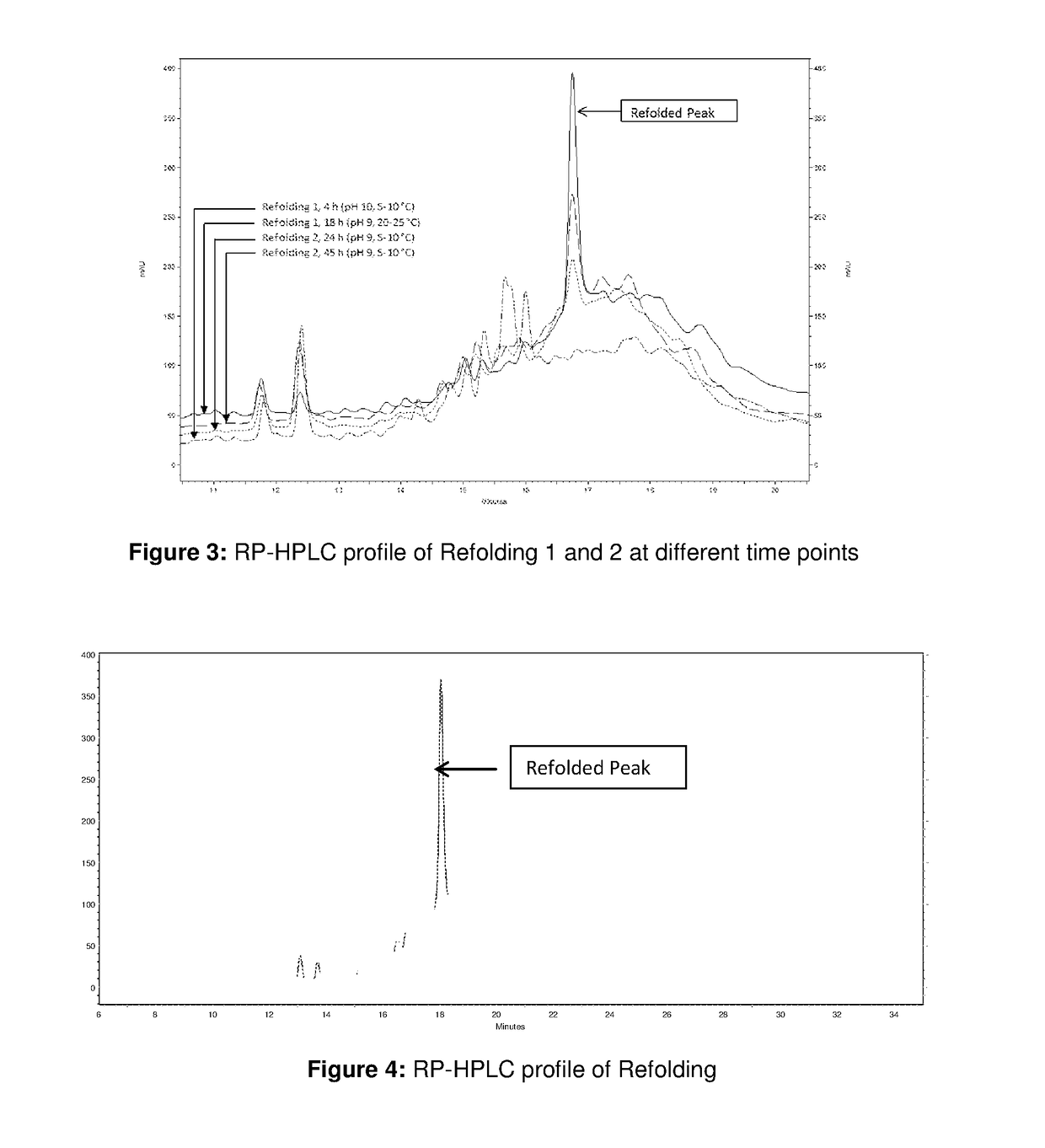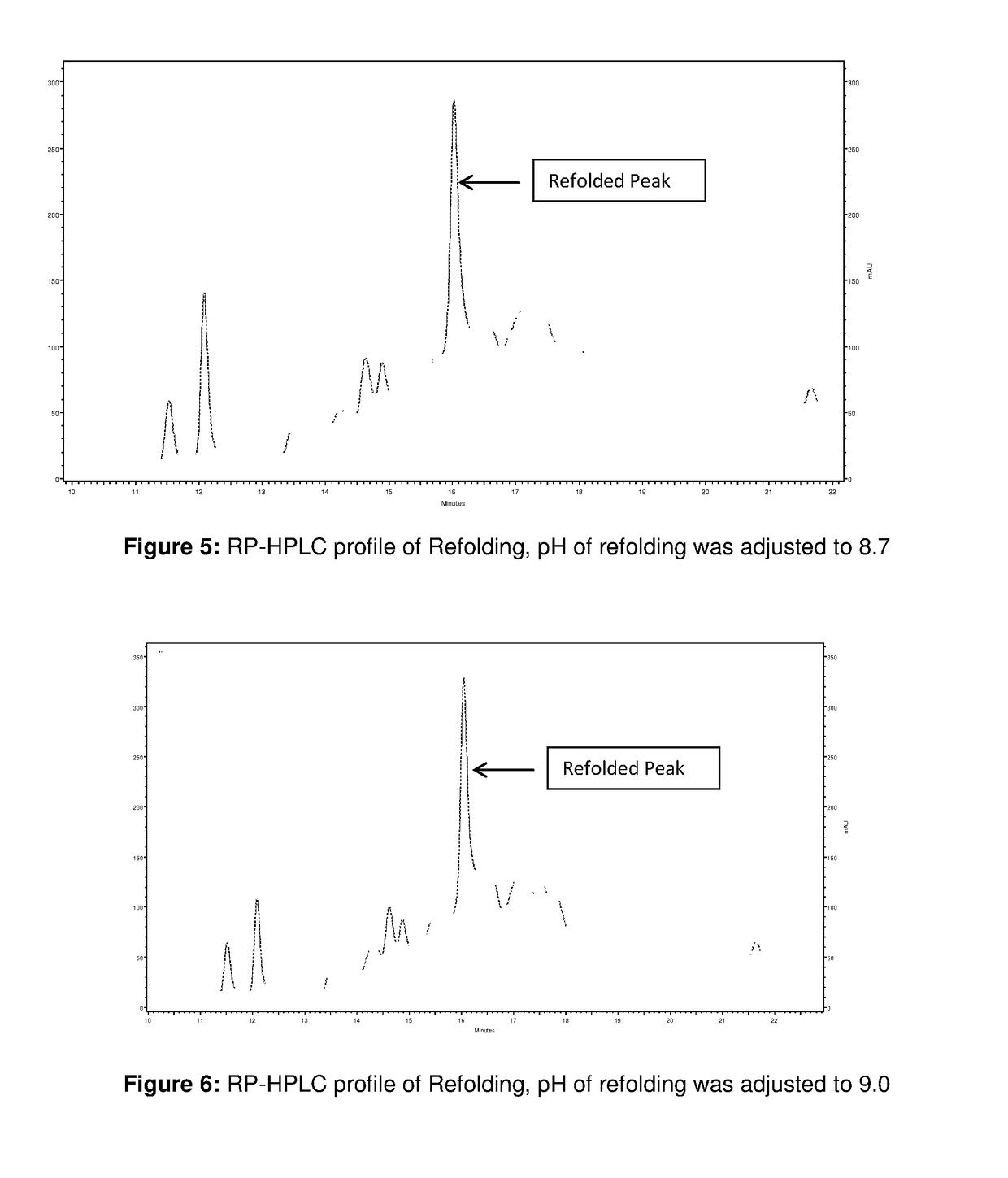Refolding Process for Antibody's Fragments
a technology of antibody fragments and refolding, which is applied in the field of refolding process of antibody fragments, can solve the problems of not being scalable at industrial scale, unable to form ibs and refold insoluble proteins, and unable to achieve the effect of high quality and quantity of refolded proteins
- Summary
- Abstract
- Description
- Claims
- Application Information
AI Technical Summary
Benefits of technology
Problems solved by technology
Method used
Image
Examples
example 1
[0095]36 g Inclusion bodies (IBs) obtained after fermentation, harvesting and IBs isolation-were solubilized in around 720 mL of first buffer comprised of 8 M Urea, 50 mM Tris at pH 9 and reduction was done using 4 mM DTT for 45 minutes. The solubilized and reduced IBs were then filtered with 0.8+0.2 μm filter.
[0096]The profile of solubilized IBs was checked through RP-HPLC as shown in FIG. 1. The heavy chain and light chain peaks can be observed in the profile.
[0097]Around 360 ml of solubilized and reduced IBs solution was then added to around 8640 mL of refolding buffer comprised of 0.6 M Arginine, 5% sorbitol and 50 mM Tris at pH 10 and temperature of 5-10° C. within 1 h at constant flow rate. Refolding at this pH was carried out for 4 h and then the pH of the refolding solution was adjusted to 9 with an acid. The temperature was also increased to 20-25° C. after pH adjustment. Refolding was continued for further 14 hrs. The RP-HPLC profile is shown in FIG. 2 and FIG. 3 which is ...
example 2
[0098]21.5 g Inclusion bodies (IBs) obtained after fermentation, harvesting and IBs isolation were solubilized in around 430 ml of first buffer comprised of 8 M Urea, 50 mM Tris at pH 9 and reduction was done using 4 mM DTT for 45 minutes. The solubilized and reduced IBs were then filtered with 0.8+0.2 μm filter.
[0099]Around 400 ml of solubilized and reduced IBs was used and it was added to around 9.5 L of refolding buffer comprised of 0.6 M Arginine, 5% sorbitol, 50 mM Tris which was at pH 9 and temperature of 5-10° C. within 1 hr at constant flow rate. The refolding was carried out for around 45 h. This refolding is referred as Refolding 2. The purity of refolded protein obtained at 24 hours is 8.1% and yield of refolded protein obtained at 24 hours is 3.1%. The RP-HPLC profile is shown in FIGS. 2 and 3 and referred as Refolding 2. Thus, from the RP-HPLC results it was observed that Refolding 1 was giving higher refolding in 18 h compared to Refolding 2 for 45 h.
example 3
[0100]100 g Inclusion bodies obtained after fermentation, harvesting and IB washing were solubilized in 1500 ml of solubilization buffer (8 M Urea, 50 mM Tris pH 9) and reduction was done using 4 mM DTT for 45 minutes. The solubilized and reduced IBs were then filtered.
[0101]800 ml of solubilized and reduced IBs was added to ˜19 L of refolding buffer (0.6 M Arginine, 5% sorbitol, 50 mM Tris, pH 10) at 5-10° C. within 1 h at constant flow rate. The refolding at this condition was continued for around 4 to 5 h. After that three aliquot (2 L each) were removed from the 19 L refolding solution and pH of each aliquots was adjusted to 8.7, 9.0, and 9.3 respectively with 6 N HCl and refolding at this condition was continued up to 21 to 28 hours at temperature of 21 to 25° C. RP-HPLC profile of Refolding at different pH is shown in FIG. 5 to FIG. 7. The profile shows that refolding within the studied pH range gives almost similar refolding.
PUM
| Property | Measurement | Unit |
|---|---|---|
| pH | aaaaa | aaaaa |
| temperature | aaaaa | aaaaa |
| temperature | aaaaa | aaaaa |
Abstract
Description
Claims
Application Information
 Login to View More
Login to View More - R&D
- Intellectual Property
- Life Sciences
- Materials
- Tech Scout
- Unparalleled Data Quality
- Higher Quality Content
- 60% Fewer Hallucinations
Browse by: Latest US Patents, China's latest patents, Technical Efficacy Thesaurus, Application Domain, Technology Topic, Popular Technical Reports.
© 2025 PatSnap. All rights reserved.Legal|Privacy policy|Modern Slavery Act Transparency Statement|Sitemap|About US| Contact US: help@patsnap.com



